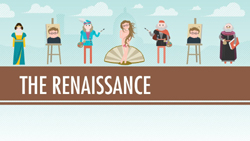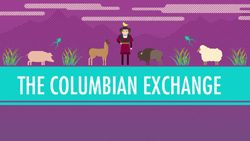| The religious and political conflicts of Seventeenth-Century
Europe were reflected in the art, literature, and political thought of
the time. Art produced during the movements of Mannerism and the
baroque aroused the emotions, and the literature spoke of the human condition.
Political thinkers debated concerns about power and order in their works.
Art After the Renaissance
-
The artistic movements of Mannerism and the baroque began
in Italy and reflected the spiritual perception of the time.
Mannerism
The artistic movement that began with the Renaissance
came to an end with Mannerism.
Mannerism emerged in Italy in the 1520's and 1530's as
a reflection of the turmoil of the time.
El Greco, "the Greek," studied art in Venice, then
came to Rome, where he became regarded as a master of the Mannerism movement.
The Baroque Period
Mannerism was replaced by the Baroque movement, which
began in Italy at the end of the sixteenth century and spread to Europe
and Latin America.
The baroque artists tried to bring together the classical
ideals of Renaissance art and the spiritual feelings of the sixteenth century
religious revival.
Baroque art and architecture reflected a search for power--
baroque churches and palaces were magnificent and richly detailed.
Kings and princes wanted others to be in awe of their power.
REVIEW & DO
NOW
Answer the following questions in your spiral notebooks: |
| What was Mannerism? |
What was the Baroque movement?
—What did Baroque artists try to do? |
|
|
Golden Age of Literature
Shakespeare and Lope de Vega were prolific writers of
dramas and comedies that reflected the human condition.
England’s Shakespeare
William Shakespeare was a playwright, an
actor, a master of the English language, and a shareholder in the theater
company he worked for.
The Globe Theater was affordable even for lower classes.
Spain’s Cervantes and Vega
Miguel de Cervantes' novel Don Quixote is recognized as
one of the greatest literary works of all time.
In the novel, Don Quixote’s down-to-earth sidekick was
Sancho Panza.
The first professional theaters in Madrid and Seville
were run by actors' companies, the same as in England.
Lope de Vega
Spanish playwright
REVIEW & DO
NOW
Answer the following questions in your spiral notebooks: |
Who was William Shakespeare?
—Why is he so highly regarded? |
Who was Miguel de Cervantes?
—What is regarded as his greatest work? |
|
|
Political Thought
-
Hobbes and Locke wrote very different books about political
thought in response to the English revolutions.
Hobbes
Thomas Hobbes
Thomas Hobbes claimed that without government, human life
was 'solitary, poor, nasty, brutish, and short.'
Hobbes published Leviathan in 1651.
In it, he argued that, to keep from destroying one another,
men made a social contract and formed a state, establishing a government.
Hobbes’s arguments were used to justify absolute power.
Locke
John Locke
An Enlightenment philosopher
In his Two Treatises of Government, 1690, John
Locke argued that before society was organized, humans had natural rights.
Natural Rights are the rights everyone is
born with as a human—including life, liberty, and the ownership of property.
Locke argued that people originally agreed to establish
governments to protect their rights.
Social Contract
the agreement by which people define and limit their
individual rights, which created an organized society or government
Locke’s arguments were used in the eighteenth century
to support demands for constitutional government.
REVIEW & DO
NOW
Answer the following questions in your spiral notebooks: |
| Who was Thomas Hobbes?
What did he say life was like before society was organized?
What was his answer to this problem?
|
Who was John Locke?
What did he mean by ‘natural rights’?
What did he believe was the purpose of government?
What did he believe people had the right to do if government
failed to live up to its responsibilities? |
|
|
|





